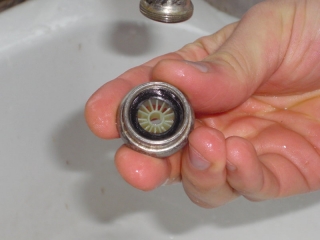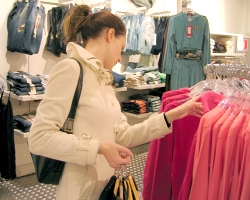Water-saving: how-to fit water-saving aerators to taps
A few weeks ago, I found out that our local water company Yorkshire Water was giving away some water-saving gizmos to its customers. Our water isn’t metered here so we’re not interested in saving water to save money, but more interested in it from a green point of view — and I guess getting into the habit in case we ever do get a water meter fitted.
As well as a shower aerator, a pretty pointless thing for the toilet cistern and a four-minute shower timer (which I’ll use for eggs), we got two tap aerators and a fitting tool.
We fitted one of the tap aerators in the kitchen yesterday and we’re already noticing the difference. It doesn’t feel like we’re getting less water when we’re washing our hands etc but it takes considerably longer to fill a glass/the kettle – showing how much it’s reduced the water flow.
It was really easy to fit the aerator – you don’t need to turn off the water (well, you do at the tap, but not at the stop cock) and we didn’t even need to use the tool provided (I’m guessing it was a wrench type thing to unscrew tight bits).
Let’s start with a shot of water running from the existing tap – for comparison.
Start by unscrewing the very end bit of the tap. You might need the tool or a wrench if it’s tightly attached. Ours screwed off easily with just a bit of a manly grasp (not a euphemism).
Read MoreHow can you tell when something is good quality?
This is another cross-post between The Really Good Life and my recycling blog, How Can I Recycle This?
The first stage of the recycling triangle is Reduce – reduce the amount of things you buy/use and buy items that’ll last and can be repaired rather than ones that need replacing frequently. A key rule of frugal living is similar: don’t pay twice for something – a more expensive quality item might last two-three-four-times longer than the cheaper alternative.
But how can you tell when something is good quality – that it’s worth the extra money and it’ll last?
Back in the day, it used to be all about price – better quality items made with better quality materials cost more. But the rise of all powerful brands put an end to that. Now poor quality items made from poor quality materials command a huge price if they’ve got the right logo on them. And once respected brands have lowered their quality, or spun off lower quality ranges, without dropping their prices, hoping we won’t notice the difference. I’ve used a picture of clothes because the fashion mark-up is really obvious with them, but it’s an issue across the board: clothes, food, homewares, tools, electronics, cars, cleaning products…
Whenever we’re making major purchases, we look up reviews online/tap the expertise of friends on Twitter to ask their opinions but people have a habit of suggesting the thing they have/use rather than the best thing: partly because it’s often all they have experience of and partly because the more people who join them helps justify it’s their decision. Most people I know have their own area of expertise – for example, I know a lot of geeks and they know from painful experience what computers should be bought and what should be avoided like the plague – but outside their area of knowledge, they’re at a bit of a loss.
So how do you tell what’s good and what isn’t? What cues tell you when something is worth the extra money? And when it definitely isn’t?
Do you have a particular area of expertise? If so, tell us all about it!
Read More





